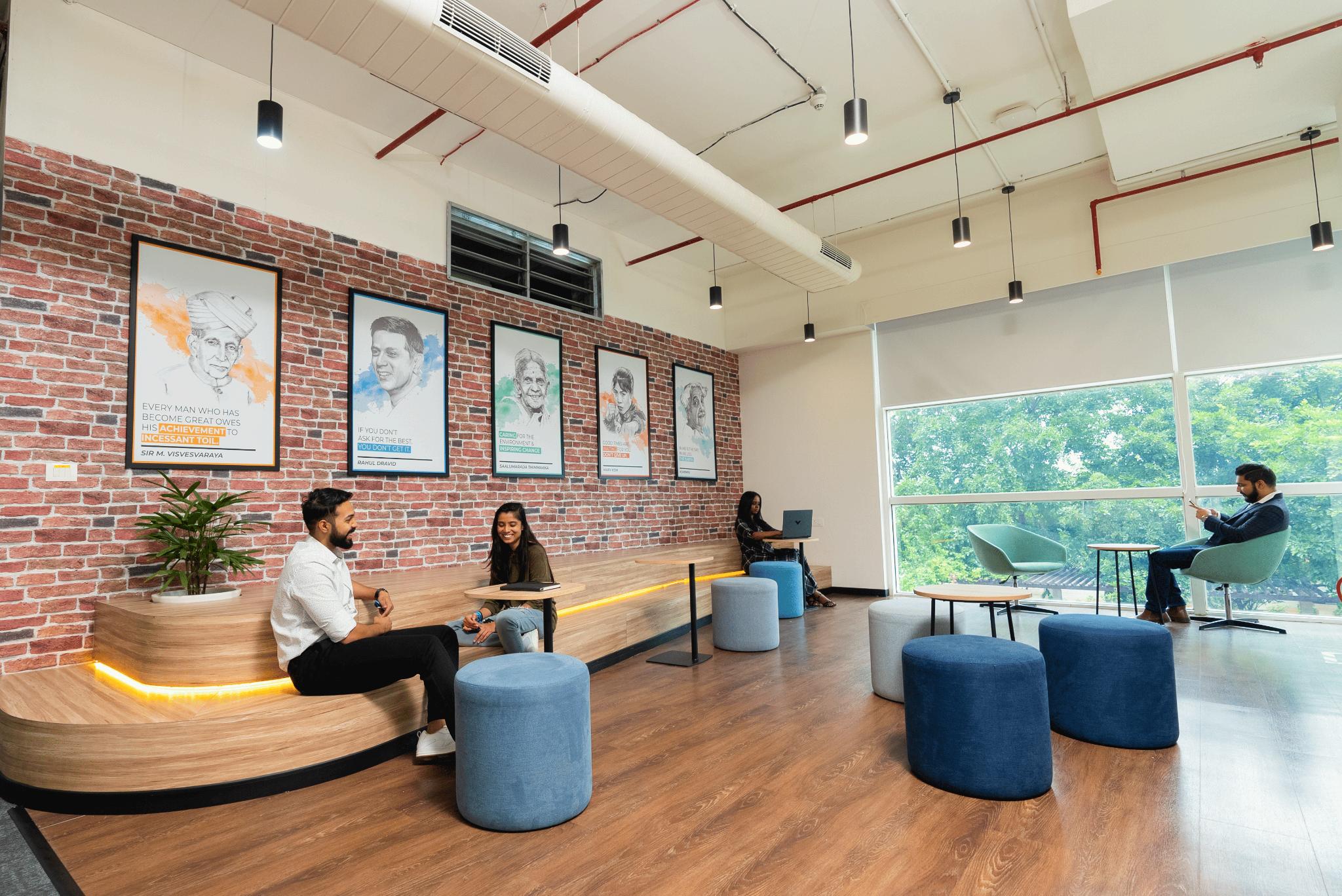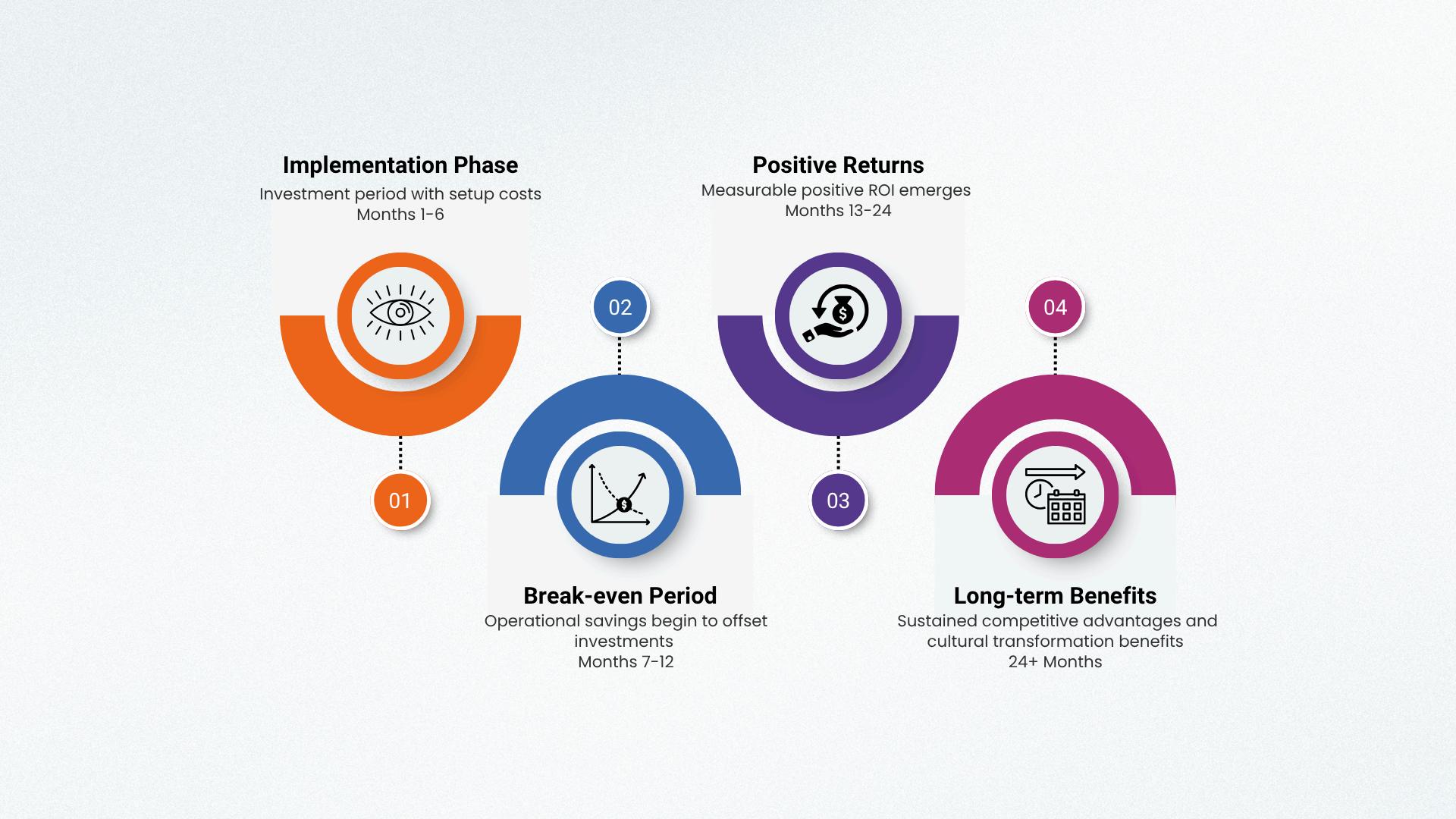PRIDEOFPLACE:





A Case Study on the Correlation Between Workplace Maintenance Standards and Employee Engagement
Authored by Rajat Dhruva R
This case study examines the relationship between strategic workplace maintenance practices and employee ownership behaviours across multiple organisational contexts Through analysis of workplace psychology research, maintenance industrydata,andorganisationalbehaviourpatterns,we demonstrate that systematic maintenance approaches directly influence employee engagement, retention, and performance outcomes Research consistentlyshowsthatcharacteristicsofthephysical office environment significantly affect employee behaviour, perceptions, and productivity (Kampschroer&Heerwagen,2005).
The modern workplace faces unprecedented challenges in employee engagement and retention Recent data indicates that only 15 percent of employees are engaged in the workplace according to Gallup's State of the Global Workplace (Haiilo,2024) Furthermore,engagementlevelsdroppedback to pre-pandemic levels with 56% of employees engaged, leaving 44% disengaged (People Element, 2024). While organisations invest heavily in technology, benefits, and culture initiatives, many overlook a fundamental factor that shapesdailyemployeeexperience:thephysicalworkenvironment anditsmaintenancestandards
This study explores how strategic maintenance practices create what we term "Pride of Place" a psychological state where employees develop emotional investment in their workplace environment, leadingtomeasurableimprovementsinownershipbehavioursandbusinessoutcomes


Figure 1: An inspiring, well-maintained breakout area that promotes informal collaboration and individual focus, highlighting how curated environments fosterasenseofownershipandengagement amongemployees
Environmental psychology research establishes clear connections between physical environment quality and human behaviour Wilson and Kelling (1982) introduced the "Broken Window Theory," demonstrating how environmental cues signal acceptable standards and influence subsequent behaviours. In workplace contexts, this theoretical framework hasbeenextensivelyvalidatedthrough empiricalresearch.
Contemporary research suggests that workplace design can significantly affect organisational and employee outcomes, including communication, collaboration, creativity, and higher employee engagement (Kampschroer & Heerwagen, 2005; Chan et al, 2007) Drawing from theories of workplace identification that integrate research on environmental psychology, organisational behaviour, and workplace design, scholars demonstrate how physical landscapes shape work experiences.
Traditional maintenance approaches focus purely on functionality, keeping systems operational and addressing breakdowns. However, emerging research demonstrates that maintenance practices serve as powerful organisational communication tools. Studies examining workplace environment impact on employee performance reveal significant mediating effects through employee commitment and taskperformance(Chenetal,2022)

Research shows that employees who have control over their workspace and can personalise it are more satisfied,motivated,andproductive,suggestingthatmaintenancepracticesthatenableemployee environmentalcontrolcontributetoengagementoutcomes(Vischer,2008)
Thisanalysissynthesisesfindingsfrommultipleresearchdomains:
● Environmentalpsychologyliteratureonworkplacedesignimpacts
● Organisationalbehaviourstudiesonemployeeengagementandcommitment
● Facilitymanagementresearchonmaintenanceeffectiveness
● Industrialpsychologyresearchonenvironmentalfactorsandperformance
● Cost-benefitanalysesfrommaintenanceindustryreports
The studyemploysamixed-methodsapproach,combiningquantitativedatafromengagementsurveys andoperationalmetricswithqualitativeinsightsfromworkplacebehaviourresearch
1. Environmental Signalling Theory Research demonstrates that physical office environments significantly influence employee behaviour, perceptions, and productivity (Kampschroer & Heerwagen, 2005) Well-maintained environments communicate organisational competence and care throughmultiplesignallingmechanisms:
● Attentiontodetailsignalsleadershippriorities
● Consistentmaintenancedemonstrateslong-termorganisationalthinking
● Environmentalinvestmentindicatesemployeevalueprioritisation
● Professionalstandardsmaintenancereflectsoverallorganisationalcompetence
2. Psychological Ownership Theory Pierce et al. (2001) established that psychological ownership emerges when individuals invest time, energy, and attention in objects or environments When employees observe systematic care for shared spaces, they naturally adopt similar care behaviours through:
● Increasedpersonalresponsibilityforworkspacemaintenance
● Proactiveidentificationandreportingofmaintenanceissues
● Voluntaryparticipationinworkplaceimprovementinitiatives
● Enhancedprideinworkplacepresentationtovisitors
3. Environmental Psychology and Well-being Systematic research indicates potential influence of physicalworkplacecharacteristics(includinglight,noise,andairquality)onemployees'mentalhealth (Vischer, 2008) Theworkplaceenvironmentsignificantlyimpactsemployeepsychologicalwellbeing, withresearchdemonstratingrelationshipsbetweenenvironmentalfactorsandjobstrain.

Research on engaged employees demonstrates significant organisational benefits When employees are highly engaged: Turnover drops by 51%. This helps to create stability and reduce the costs associated with recruiting and onboarding new talent Employee well-being improves by 68% (LindauerGlobal,2024)
Organisations implementing strategic maintenance approaches demonstrate patterns across multiple performance domains, though specific percentage improvements vary significantly based on organisational context, industry, and implementation quality Research consistently demonstratesthat

Strategic maintenance implementation requires systematic investment across multiple categories basedonorganisationalsizeandcomplexity:
ProcessDevelopment:Enhancedplanninganddocumentationsystems
● Policyandproceduredevelopment
● Trainingmaterialcreation
● Communicationsystemestablishment
● Performancemeasurementsystemdesign
TrainingandCommunication:Staffdevelopmentandengagementactivities
● Stafftrainingonnewprocedures

● Employeecommunicationandengagementactivities
● Managementtrainingoncultureintegration
● Ongoingcommunicationsystemmaintenance
EnhancedServiceLevels:Improvedmaintenancestandards
● Increasedfrequencyofpreventivemaintenance
● Enhancedqualitystandardsimplementation
● Extendedservicecoverageareas
● Improvedresponsetimecapabilities
MeasurementandMonitoring:Performancetrackingsystems
● Performancetrackingsystemimplementation
● Employeesatisfactionmeasurement
● Operationalmetricscollectionandanalysis
● Continuousimprovementprocesssupport
DirectCostSavings:
● Emergency Maintenance Reduction: Significant decrease in unplanned maintenance expenses
● EquipmentLifecycleExtension:Longerassetusefullifethroughpreventivecare
● EnergyEfficiencyImprovements:Reducedutilitycoststhroughbettermaintenance
IndirectBenefitsbasedonresearch:
● EmployeeRetentionValue:Substantialsavingsperretainedemployee(SHRM,2022)
● ProductivityImprovements:Gainsinoveralloperationalefficiency
● RecruitmentCostReduction:Decreasedhiringandonboardingexpenses
● ClientSatisfactionEnhancement:Improvementsinbusinessdevelopmentsuccess
Many customers see areturnintheirfacilitymanagementsoftwareinvestmentrightaway Inthemost recent customer survey, 27% reported they saw immediate ROI. Another 25% said thesoftwarepaid foritselfwithinonetothreemonths(iOffice,2022).


Start with High-Impact, High-Visibility Areas Research on workplace design impact suggests focusing initial efforts on spaces where employees spend most time generatesmaximumbehavioural impact(Vischer,2008) Priorityareasinclude:
● Primaryworkareasandcollaborativespaces
● Entrypointsandreceptionareas
● Breakroomsandsocialgatheringspaces
● Meetingroomsandclient-facingareas
Communicate Intentionally and Systematically Effective communication strategies based on organisationalbehaviourresearchinclude:
● Regularupdatesonmaintenanceinvestmentsandimprovements
● Publicschedulesandcompletiontrackingsystems
● Recognitionofbothmaintenancestaffandemployeecontributors
● Integrationintobroaderorganisationalcommunicationchannels
MeasureComprehensivelyBalancedmeasurementapproachesshouldtrack:
● OperationalMetrics:Responsetimes,costs,incidentrates,equipmentperformance
● CulturalMetrics:Employeesatisfaction,engagementscores,voluntaryparticipationrates
● BusinessMetrics:Clientfeedback,recruitmentsuccess,retentionrates

Sustain Through Leadership Commitment Long-term success requires systematic leadership supportincluding:
● Budgetallocationprioritisingpreventiveoverreactiveapproaches
● Recognitionsystemscelebratingmaintenanceexcellence
● Integrationoffacilityprideintoorganisationalvaluesandperformancemetrics
● Continuousinvestmentinimprovementandinnovation
TheoreticalContributions
Thisresearchcontributestoexistingliteratureby:
● Integratingenvironmentalpsychologywithorganisationalbehaviourtheory
● Demonstratingrelationshipsbetweenmaintenancepracticesandemployeeoutcomes
● Establishingasystematicframeworkformaintenance-cultureintegration
● Providingsupportforstrategicmaintenanceinvestmentdecisions
Fororganisationalleaders,thisresearchsuggests:
● Maintenance should be considered a strategic organisational investment rather than operationalexpense
● Environmentalfactorssignificantlyinfluenceemployeeengagementandretention
● Systematic approaches to maintenance can generate measurable ROI through multiple channels
● Culturechangethroughenvironmentalmanagementisachievableandsustainable
Thisstudyacknowledgesseverallimitations:
● Industryvariationinmaintenanceimpactmayrequiresector-specificanalysis
● Organisationalsizeeffectsonimplementationsuccessneedfurtherinvestigation
● Long-termsustainabilityofculturechangerequireslongitudinalstudy
● Cost-benefitcalculationsmayvarysignificantlybasedonregionalandindustryfactors
Strategic maintenance represents a significant opportunity for organisations seeking to improve employee engagement, reduce operational costs, and create sustainable competitive advantages Research demonstrates clear relationships between workplace environment and employee performancethroughcommitmentandachievementmechanisms(Chenetal.,2022).

The "Pride of Place" effect demonstrates that systematic attention to workplace maintenance creates psychological and cultural benefits extending far beyond facility functionality. Evidence consistently shows that physical office environment characteristics significantly affect employee behaviour, perceptions,andproductivity(Kampschroer&Heerwagen,2005)
Organisations recognising maintenance as a strategic culture-building tool position themselves to attract and retain top talent, reduce operational costs, and create work environments driving superior performance outcomes The evidence demonstrates that strategic maintenance influences employee ownershipandengagement,withimplementationqualitydeterminingbenefitrealisationtimelines.
At WorkFix,weoperationalisetheinsightsfromthisresearchbyturningmaintenanceintoapowerful driver of workplaceculture,notjustfunctionality Ourplatformempowersorganisationstoimplement preventive maintenance seamlessly,tracktechniciansinrealtime,andrequestforservicesthroughthe platform. More thanjustfixingwhat'sbroken,WorkFixhelpscompaniesbuildspacestheiremployees are proud to work in,whereeveryrepair,upgrade,orupkeepactionsignalscare,professionalism,and culture By bridging operational excellence with psychological impact, WorkFix helps companies transform maintenance from a back-end task into a front-line strategy for engagement,retention,and growth

Brightly Software (2024) The ROI of Preventive Maintenance: Is It Really Worth It? Available at: https://www.brightlysoftware.com/learning-center/ROI-preventive-maintenance (Accessed: 13 June 2025).
Chan, J, Beckman, S and Lawrence, P (2007) 'Workplace design: A new managerial imperative', California Management Review,49(2),pp.6-22.
Chen, Y, Feng, J, Yuan, B, Ma, Y andZuo,J (2022)'Impactofemployees'workplaceenvironment onemployees'performance:Amulti-mediationmodel', Frontiers in Public Health,10,p 890400 doi: 10.3389/fpubh.2022.890400.
Culture Amp (2024) The Great Regression: Employee engagement in 2024 Available at: https://www.cultureamp.com/blog/employee-engagement-2024(Accessed:13June2025).
Haiilo (2024) 10 Employee Engagement Statistics You Need to Know in 2024 Available at: https://bloghaiilocom/blog/employee-engagement-8-statistics-you-need-to-know/(Accessed:13June 2025).
iOffice (2022) When Can I Expect To See ROI From My Facility Management Software? Availableat: https://wwwquickfmscom/blog/when-can-you-expect-roi-from-facility-management-software-quickf ms(Accessed:13June2025).
Kampschroer, K and Heerwagen, J (2005) 'The strategic workplace: Development and evaluation', Building Research & Information,33(4),pp.326-337.
Lindauer Global (2024) The Power of Employee Engagement: Gallup's 2024 State of the Global Workplace Available at: https://www.lindauerglobal.com/insight/employee-engagement-gallup-global-workplace-report/ (Accessed:13June2025).
People Element (2024) 2024 Employee Engagement Report Available at: https://peopleelement.com/blog/2024-employee-engagement-report/(Accessed:13June2025).
Pierce, JL, Kostova, T and Dirks, KT (2001) 'Toward a theory of psychological ownership in organizations', Academy of Management Review,26(2),pp 298-310
SHRM (2022) Human Capital Benchmarking Report Alexandria, VA: Society for Human Resource Management
Vischer, J.C. (2008) 'Towards an environmental psychology of workspace: How people are affected byenvironmentsforwork', Architectural Science Review,51(2),pp 97-108
Wilson, J.Q. and Kelling, G.L. (1982) 'Broken windows: The police and neighborhood safety', The Atlantic Monthly,249(3),pp.29-38.
